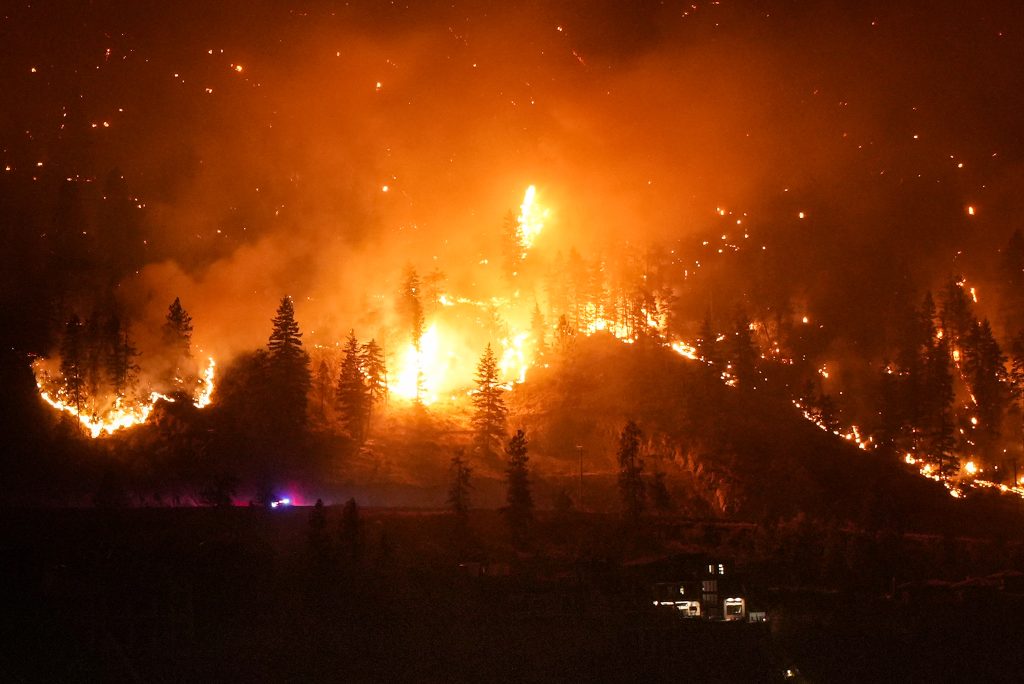Ahead of likely ‘ferocious’ wildfire season, fire chiefs lament drop in volunteers

Posted Apr 11, 2024 11:23 am.
As Canada looks ahead to what experts fear could be another devastating wildfire season, fire chiefs say they are worried about the dwindling number of volunteers available to combat the rising threat.
Ken McMullen, president of the Canadian Association of Fire Chiefs, which represents 3,200 fire departments across the country, says his group’s data shows that the number of volunteer firefighters is diminishing as the volume of emergency calls increases.
“And all indications are showing that wildfire season 2024 will be as ferocious as last year’s, and we have to prepare better for that than we did for the summer of 2023,” McMullen said in a recent interview.
Last year’s fire season required the efforts of nearly all of the country’s firefighters, both career and volunteer, McMullen said. As detachments fought out-of-control wildfires, many firefighters who weren’t directly fighting those blazes were dispatched to cover the shifts of those sent to the front lines.
As of 2023, there were 125,500 firefighters in Canada, of which about 88,500 were volunteers, whose departments protected 80 per cent of the country’s territory, including many of the remote and rural areas where wildfires are often sparked.
There is no consistent regional or municipal model for compensating volunteer firefighters. Some receive nothing but a federal tax credit for their service; others get some form of payment for the calls they attend or an honorarium, but they do not draw a living wage from firefighting.
Between 2016 and 2023, Canada lost more than 30,000 firefighters, most of them volunteers, McMullen said. Another 1,000 volunteer firefighters left between 2022 and 2023, and McMullen said he worries the lingering impacts of last year’s record-breaking fire season will lead to more resignations.
“We asked volunteer firefighters to respond for weeks and months at a time last year, leaving behind their responsibilities, their employment, their parental or spousal duties. All of that gets put aside while these individuals go and attend to our fires,” McMullen said.
“That is not sustainable, and we are seeing that now with the reduction of firefighters in this country, particularly volunteer firefighters, because at the end of last season some people just said, ‘I’m done. I can’t do this anymore.’”
Persistent drought and months of above-average temperatures have raised the risk of a repeat of last year’s record-breaking wildfires, prompting federal ministers to wave a red warning flag about the desperate need to address climate change.
“We can expect that the wildfire season will start sooner, end later and potentially be more explosive,” Emergency Preparedness Minister Harjit Sajjan told a news conference Wednesday.
The 2023 fire season was Canada’s worst on record, burning more than 15 million hectares and forcing more than 230,000 people from their homes. It also created unprecedented smoke conditions across much of the country and in the United States.
A briefing document forecasting the fire risk for the spring shows conditions are already ripe this year for an early and above-normal fire risk from Quebec to British Columbia in both April and May. The forecast is based on Canada having had a warmer-than-normal winter with minimal snow and widespread drought, particularly in the Prairies. There is also a high probability for above-normal temperatures in April, May and June.
Michael Lockett, a volunteer firefighter in Nova Scotia’s Annapolis Valley, said last year’s devastating fires in the province were unlike anything he’s seen in his 35-year career. “Last year was an unprecedented year,” Lockett said.
The Barrington Lake fire southwest of Shelburne, N.S., was ignited on May 26, 2023, and burned 23,000 hectares before it was brought under control on June 13 and extinguished more than a month later amid heavy rain. The fire forced the evacuation of more than 6,000 people and destroyed 60 homes and cottages, as well as 150 other structures.
The fire in the southwestern corner of Nova Scotia erupted two days before another devastating wildfire started in the Upper Tantallon area amid a large swath of suburban neighbourhoods surrounded by woodlands northwest of Halifax. That fire burned 969 hectares, destroyed 151 homes and forced more than 16,000 residents to flee the area.
Volunteer fire departments across the province were deployed to respond to both massive blazes as well as smaller wildfires across Nova Scotia.
Lockett said last year’s historic season increased awareness of fire safety and the importance of reporting smoke sightings, but it did not result in many new recruits.
“People want to help … They’d love to come out and spray some water, but once they realize the commitment and training and meetings required (to be a volunteer firefighter), they’re gone.”
Hilliard Ewing, a volunteer fire captain with the Middleton Fire Department in Nova Scotia, said he expects the extensive, unpaid training required makes it difficult for many people who work full-time to join a volunteer department.
“It’s important, and you need to be trained at that high level, but to do that and be ready to put your life at risk, the time commitment is just huge,” he said.
The federal government has said it is responding to the need for more hands on deck to fight fires by doubling the tax credit for volunteer firefighters to $6,000.
McMullen said it’s not quite what the chiefs had asked for, but he said he was glad to hear Ottawa acknowledge the important work of volunteers. He said his association will continue to make the case for a $10,000 tax credit, which he said is an amount that reflects the high cost of living as well as the vital role volunteer firefighters play in protecting Canadians.
There are already about 70 fires burning across Canada, mainly in B.C., Alberta and the Northwest Territories. Most of those are fires that started in 2023, smouldered underground throughout the winter and have since re-emerged.
— With files from Mia Rabson in Ottawa.








